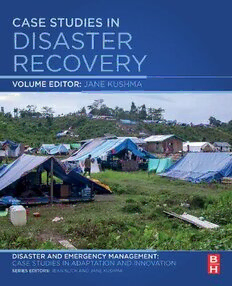
Case Studies in Disaster Recovery: A Volume in the Disaster and Emergency Management: Case Studies in Adaptation and Innovation Series PDF
Preview Case Studies in Disaster Recovery: A Volume in the Disaster and Emergency Management: Case Studies in Adaptation and Innovation Series
Case Studies in Disaster Recovery A Volume in the Disaster and Emergency Management: Case Studies in Adaptation and Innovation Series Disaster and Emergency Management: Case studies in adaptation and innovation Series editors Jean Slick DisasterandEmergencyManagementProgram,RoyalRoadsUniversity,Victo- ria, BC, Canada Jane Kushma Emergency Management Program, Jacksonville State University, Jacksonville, AL, UnitedStates Forthcoming volumes in the series (cid:129) CaseStudiesinDisasterResponse,editedbyStevenJensen,DavidJohnston,and ShirleyFeldmann-Jensen (cid:129) CaseStudiesinDisasterMitigationandPrevention,editedbyHimanshuGrover TanveerIslam, and Jean Slick (cid:129) CaseStudiesinDisasterPreparedness, edited by Joanne McGlown Case Studies in Disaster Recovery A Volume in the Disaster and Emergency Management: Case Studies in Adaptation and Innovation Series Edited by Jane Kushma Butterworth-HeinemannisanimprintofElsevier TheBoulevard,LangfordLane,Kidlington,OxfordOX51GB,UnitedKingdom 50HampshireStreet,5thFloor,Cambridge,MA02139,UnitedStates Copyright©2023ElsevierInc.Allrightsreserved. Nopartofthispublicationmaybereproducedortransmittedinanyformorbyany means,electronicormechanical,includingphotocopying,recording,oranyinformation storageandretrievalsystem,withoutpermissioninwritingfromthepublisher.Detailson howtoseekpermission,furtherinformationaboutthePublisher’spermissionspolicies andourarrangementswithorganizationssuchastheCopyrightClearanceCenterandthe CopyrightLicensingAgency,canbefoundatourwebsite:www.elsevier.com/permissions. Thisbookandtheindividualcontributionscontainedinitareprotectedundercopyright bythePublisher(otherthanasmaybenotedherein). Notices Knowledgeandbestpracticeinthisfieldareconstantlychanging.Asnewresearchand experiencebroadenourunderstanding,changesinresearchmethods,professional practices,ormedicaltreatmentmaybecomenecessary. Practitionersandresearchersmustalwaysrelyontheirownexperienceandknowledgein evaluatingandusinganyinformation,methods,compounds,orexperimentsdescribed herein.Inusingsuchinformationormethodstheyshouldbemindfuloftheirownsafety andthesafetyofothers,includingpartiesforwhomtheyhaveaprofessional responsibility. Tothefullestextentofthelaw,neitherthePublishernortheauthors,contributors,or editors,assumeanyliabilityforanyinjuryand/ordamagetopersonsorpropertyasa matterofproductsliability,negligenceorotherwise,orfromanyuseoroperationofany methods,products,instructions,orideascontainedinthematerialherein. ISBN:978-0-12-809574-4 ForinformationonallButterworth-Heinemannpublicationsvisit ourwebsiteathttps://www.elsevier.com/books-and-journals Publisher:CandiceJanco AcquisitionsEditor:BrianRomer EditorialProjectManager:HilaryCarr ProductionProjectManager:SuryaNarayananJayachandran CoverDesigner:MatthewLimbert TypesetbyTNQTechnologies This volume is dedicated to all those engaged in the hard work of disasterrecoverydpast,present,andfuture.Wehopethecasesinthis volume provide insights and inspiration about the roles of adaptation and innovation in pursuit of recovery from disaster. This page intentionally left blank Contents Contributors..........................................................................................xiii Aboutthe series editors...........................................................................xv Acknowledgments.................................................................................xvii Case studies indisaster and emergency management...................................xix Comparison ofcharacteristicsof adaptationand innovation across the casesin thisvolume.........................................................................xlvii Recovery volumeintroduction................................................................xlix PART 1 Early recovery CHAPTER 1 Business recovery from disaster: creating an enabling environment for surviving and thriving............................................................3 Tracy Hatton, John Vargo and EricaSeville Case summary..........................................................................3 State-of-the practice overview.....................................................3 Adaptation and innovation characteristics.....................................5 Case description.......................................................................5 Theevents........................................................................5 Impacts -overview.............................................................6 Pre-existing context.................................................................12 New Zealand economy.....................................................12 Canterbury businesscontext..............................................13 Macro-economic trends....................................................14 Sectoral trends................................................................14 Spatial trends..................................................................15 Insurance........................................................................16 Pre-existingcontextsummary............................................16 Institutional conditions e government policyresponses.................16 Earthquake Support Subsidy (ESS).....................................17 Tax leniency...................................................................18 Managing the rebuild.......................................................18 Recover Canterbury.........................................................18 Canterbury businessrecovery trust (CBRT)..........................19 Other MBIE initiatives.....................................................19 Canterbury earthquakerecovery authority (CERA)................20 vii viii Contents Christchurch central development unit (CCDU)....................20 Openfor business............................................................21 Targetedfunding for specific projects..................................21 Rebuild central................................................................21 Government policyresponses summary...............................21 Discussion.............................................................................22 Summary e creating anenablingenvironment......................24 Conclusions...........................................................................25 Recommended readings...........................................................26 Businessrecovery fromdisaster.........................................26 Organizational resilience...................................................26 Governance....................................................................27 References.............................................................................27 CHAPTER 2 Resilient recovery strategies: lessons from the local nonprofit sector following Hurricane Ike.........33 Deanna Harlene Schmidt, Kathleen Garland and Liliya Kasatkina Quebedeaux Case summary........................................................................33 State ofthe practice overview...................................................33 Adaptation andinnovation characteristics...................................34 Case description.....................................................................35 Study area andmethods....................................................36 Findings- surveys............................................................38 Keychallenges of FBSNOs indisasterresponse and recovery.........................................................................38 Findings- interviews........................................................40 Discussion.............................................................................46 Recommendations............................................................47 Conclusions...........................................................................48 References.............................................................................50 CHAPTER 3 Dedicated service in the aftermath of disasters: An organizational identity transition from latent to manifest disaster relief work.............53 Erin Rider Case summary........................................................................53 State ofthe practice overview...................................................53 Adaptation andinnovation characteristics...................................54 Case description.....................................................................55 Context..........................................................................55 Contents ix TheNPOs......................................................................56 Themes..........................................................................57 Discussion.............................................................................63 Conclusions...........................................................................64 Recommended readings...........................................................65 References.............................................................................66 CHAPTER 4 Preventing fraud versus preventing risk reduction - Are we focusing too much on making sure that people don’t cheat?.....................69 Alessandra Jerolleman,Race Hodgesand Miriam Belblidia Case summary........................................................................69 State-of-the practice overview...................................................70 Adaptation and innovation characteristics...................................72 Case description.....................................................................73 Overview.......................................................................73 SuperstormSandy............................................................75 NYC Build it Back..........................................................75 Fraud preventionefforts....................................................77 Case study findings..........................................................78 Hurricane Katrina/Hurricane Rita.......................................78 TheRoad Home..............................................................78 Fraud preventionefforts....................................................80 Case study findings.................................................................81 Discussion.............................................................................81 Comparisonof cases........................................................81 Keyrecommendations......................................................82 Conclusions...........................................................................83 References.............................................................................83 PART 2 Long-term recovery CHAPTER 5 “Reign from behind the curtain”- Women’s leadership during post-earthquake stages in rural areas in Sichuan, China.................................87 Haorui Wu Case summary........................................................................87 State-of-the practice overview...................................................88 Adaptation and innovation characteristics...................................89
